Construction of electronic cigarettes
An electronic cigarette is a handheld battery-powered vaporizer that simulates smoking, but without tobacco combustion.[1] E-cigarette components include a mouthpiece (drip tip[2]), a cartridge (liquid storage area), a heating element/atomizer, a microprocessor, a battery, and some of them have an LED light on the end.[3] An exception to this are mechanical e-cigarettes (mods) which contain no electronics and the circuit is closed by using a mechanical action switch.[4] An atomizer consists of a small heating element, or coil, that vaporizes e-liquid and a wicking material that draws liquid onto the coil.[5] When the user inhales a flow sensor activates the heating element that atomizes the liquid solution;[6] most devices are manually activated by a push-button.[7] The e-liquid reaches a temperature of roughly 100–250 °C (212–482 °F) within a chamber to create an aerosolized vapor.[8] The user inhales an aerosol, which is commonly but inaccurately called vapor, rather than cigarette smoke.[9] Vaping is different than smoking, but there are some similarities, including the hand-to-mouth action of smoking and a vapor that looks like cigarette smoke.[1] The aerosol provides a flavor and feel similar to tobacco smoking.[1] A traditional cigarette is smooth and light but an e-cigarette is rigid, cold and slightly heavier.[1] There is a learning curve to use e-cigarettes properly.[10] E-cigarettes are cigarette-shaped,[11] and there are many other variations.[12] E-cigarettes that resemble pens or USB memory sticks are also sold that may be used unobtrusively.[13]
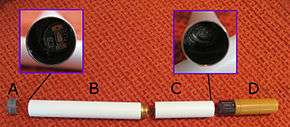
A. LED light cover
B. battery (also houses circuitry)
C. atomizer (heating element)
D. cartridge (mouthpiece)
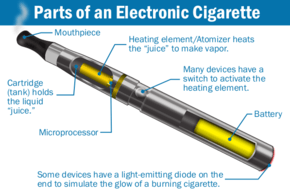
There are three main types of e-cigarettes: cigalikes, looking like cigarettes; eGos, bigger than cigalikes with refillable liquid tanks; and mods, assembled from basic parts or by altering existing products.[14] Cigalikes are either disposable or come with rechargeable batteries and replaceable nicotine cartridges.[15] A cigalike e-cigarette contains a cartomizer, which is connected to a battery.[16] A "cartomizer" (a portmanteau of cartridge and atomizer[17]) or "carto" consists of an atomizer surrounded by a liquid-soaked poly-foam that acts as an e-liquid holder.[5] Clearomizers or "clearos", not unlike cartotanks, use a clear tank in which an atomizer is inserted.[18] A rebuildable atomizer or an RBA is an atomizer that allows users to assemble or "build" the wick and coil themselves instead of replacing them with off-the-shelf atomizer "heads".[19] The power source is the biggest component of an e-cigarette,[20] which is frequently a rechargeable lithium-ion battery.[12]
As the e-cigarette industry continues to evolve, new products are quickly developed and brought to market.[21] First-generation e-cigarettes tend to look like traditional cigarettes and so are called "cigalikes".[19] Most cigalikes look like cigarettes but there is some variation in size.[16] Second-generation devices are larger overall and look less like traditional cigarettes.[22] Third-generation devices include mechanical mods and variable voltage devices.[19] The fourth-generation includes sub ohm tanks and temperature control devices.[23] The voltage for first-generation e-cigarettes is about 3.7[24] and second-generation e-cigarettes can be adjusted from 3 V to 6 V,[25] while more recent devices can go up to 8 V.[24] The latest generation of e-cigarettes are pod mods,[26] which provide higher levels of nicotine than regular e-cigarettes[27] through the production of aerosolized protonated nicotine.[28]
E-liquid is the mixture used in vapor products such as e-cigarettes[29] and usually contain propylene glycol, glycerin, nicotine, flavorings, additives, and differing amounts of contaminants.[30] E-liquid formulations greatly vary due to fast growth and changes in manufacturing designs of e-cigarettes.[16] The composition of the e-liquid for additives such as nicotine and flavors vary across and within brands.[31] The liquid typically consists of a combined total of 95% propylene glycol and glycerin, and the remaining 5% being flavorings, nicotine, and other additives.[32] There are e-liquids sold without propylene glycol,[33] nicotine,[34] or flavors.[35] The flavorings may be natural, artificial,[31] or organic.[36] Over 80 chemicals such as formaldehyde and metallic nanoparticles have been found in the e-liquid.[37] There are many e-liquids manufacturers in the US and worldwide,[38] and more than 15,500 flavors existed in 2018.[39] Under the US Food and Drug Administration (FDA) rules, e-liquid manufacturers are required to comply with a number of manufacturing standards.[40] The revision to the EU Tobacco Products Directive has some standards for e-liquids.[41] Industry standards have been created and published by the American E-liquid Manufacturing Standards Association (AEMSA).[42]
Use
Function
.jpg)
An e-cigarette is a handheld battery-powered vaporizer that simulates smoking, but without tobacco combustion.[1] Once the user inhales, the airflow activates the flow sensor, and then the heating element atomizes the liquid solution.[6] The different kinds of trigger sensor or sensors used are acoustic, pressure, touch, capacitive, optical, Hall Effect or electromagnetic field.[43] Most devices have a manual push-button switch to turn them on or off.[7] E-cigarettes do not turn on by trying to "light" the device with a flame.[12] The e-liquid reaches a temperature of roughly 100-250 °C within a chamber to create an aerosolized vapor.[8] However, variable voltage devices can raise the temperature.[31] A glycerin-only liquid vaporizes at a higher temperature than a propylene glycol-glycerin liquid.[31] Rather than cigarette smoke, the user inhales an aerosol, commonly but inaccurately called vapor.[9] E-cigarettes do not create vapor between puffs.[44]
Perception
Vaping is different than tobacco smoking, but there are some similarities with their behavioral habits, including the hand-to-mouth action and a vapor that looks like cigarette smoke.[1] E-cigarettes provide a flavor and feel similar to smoking.[1] A noticeable difference between the traditional cigarette and the e-cigarette is sense of touch.[1] A traditional cigarette is smooth and light but an e-cigarette is rigid, cold and slightly heavier.[1] Since e-cigarettes are more complex than traditional cigarettes, a learning curve is needed to use them correctly.[10]
Compared to traditional cigarettes, the general e-cigarette puff time is much longer, and requires a more forceful suction than a regular cigarette.[45] The volume of vapor created by e-cigarette devices in 2012 declined with vaping.[1] Thus, to create the same volume of vapor increasing puff force is needed.[1] Later-generation e-cigarettes with concentrated nicotine liquids may deliver nicotine at levels similar to traditional cigarettes.[46] Many e-cigarette versions include a voltage control to adjust the volume of vapor created.[12] The amount of vapor produced is controlled by the power from the battery, which has led some users to adjust their devices to increase battery power.[8] Larger percentages of glycerin in e-liquid also increase vapor production.[47]
Construction
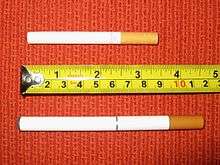
E-cigarettes come in many variations,[12] such as cigarette-shaped, pen-shaped, and tank-shaped styles.[11] Some e-cigarettes look like traditional cigarettes, but others do not.[10] There are three main types of e-cigarettes: cigalikes, looking like cigarettes; eGos, bigger than cigalikes with refillable liquid tanks; and mods, assembled from basic parts or by altering existing products.[14]
E-cigarette components include a mouthpiece, a cartridge (liquid storage area), a heating element/atomizer, a microprocessor, a battery, and some have a LED light on the end.[3] An exception to this are mechanical e-cigarettes (mods) which contain no electronics and the circuit is closed by using a mechanical action switch.[4] E-cigarettes are sold in disposable or reusable variants.[14] Most versions are reusable, though some are disposable.[48] They range in cost from under $10 to over $200.[49] An entry-level reusable e-cigarette costs around $25.[50] Disposable e-cigarettes are discarded once the liquid in the cartridge is used up, while rechargeable e-cigarettes may be used indefinitely.[51] Even with rechargeable cigarettes (pod-based systems) however, there is a risk of littering.[52][53] However, there are some thoughts on how to prevent pods from ending up in the environment (i.e. a deposit-system for e-cigarette pods) and we should remember that cigarette butts currently also pollute the environment.[54] One piece devices are normally disposable.[55] E-cigarettes are typically designed as one, two, three or multiple pieces.[55] A disposable e-cigarette lasts to around 400 puffs.[56] Reusable e-cigarettes are refilled by hand or exchanged for pre-filled cartridges, and general cleaning is required.[12] A wide range of disposable and reusable e-cigarettes exist.[43] Disposable e-cigarettes are offered for a few dollars, and higher-priced reusable e-cigarettes involve an up-front investment for a starter kit.[10] Some e-cigarettes have a LED at the tip to resemble the glow of burning tobacco.[46] The LED may also indicate the battery status.[1] The LED is not generally used in personal vaporizers or mods.[3]
First-generation e-cigarettes usually simulated smoking implements, such as cigarettes or cigars, in their use and appearance.[19] Later-generation e-cigarettes often called mods, PVs (personal vaporizer) or APVs (advanced personal vaporizer) have an increased nicotine-dispersal performance,[19] house higher capacity batteries, and come in various shapes such as metal tubes and boxes.[57] They contain silver, steel, metals, ceramics, plastics, fibers, aluminum, rubber and spume, and lithium batteries.[58] A growing subclass of vapers called cloud-chasers configure their atomizers to produce large amounts of vapor by using low-resistance heating coils.[59] This practice is known as cloud-chasing.[60] Many e-cigarettes are made of standardized replaceable parts that are interchangeable between brands.[61] A wide array of component combinations exists.[62] Many e-cigarettes are sold with a USB charger.[63] E-cigarettes that resemble pens or USB memory sticks are also sold for those who may want to use the device unobtrusively.[13]
The increasing numbers of new vaping products combined with unrelated functions attest to a clear trend toward customization of e-cigarettes.[64] It seems that experienced users like to adopt the e-cigarette to their (inhalation) needs, leading to e-cigarettes with adjusted airflow inlet using atomizer heads with different sized air holes.[64] This is applied in the most recently introduced models, which are activated by a pressure difference when the user inhales from the e-cigarette, avoiding pressing a button to heat the device.[64] Other interesting new e-cigarette-like devices provide a combined function with other electronic products such as a Bluetooth e-cigarette, which combines vaping with listening to music or calling friends and another device can be used both as e-cigarette and mobile phone.[64]
Moreover, smartphone applications were introduced that track the number of e-cigarette puffs taken, calculate cost savings and increased life expectancy, and have features such as auto-shut down and password protection safety.[64] In line with this, Phillip Morris International has filed a patent for an e-cigarette that is Wi-Fi connected, and thus would be able to connect to other devices.[64] This device could potentially synchronize to a smartphone application that is intended to help people quit smoking, and carefully track their progress.[64] A similar product is the Vaporcade Jupiter, a "cellular vaporizer," combining a smartphone with an e-cigarette.[64] This allows the user to monitor the e-cigarette use, the e-liquid remaining, and the flavor used.[64]
Device generations
As the e-cigarette industry continues to evolve, new products are quickly developed and brought to market.[21] The early devices looked like a traditional cigarette, often including a small light on the tip that lit when the user puffed.[65] These early systems were generally inefficient at delivering nicotine, in part because the particle sizes of the aerosol were too large to penetrate deep into the lungs.[65] Newer versions feature replaceable or refillable reservoirs and rechargeable batteries that generate smaller particles and more efficient nicotine delivery.[65] Since e-cigarettes are not regulated in many countries, the device designs can change often.[66] There is wide differences in the quality of e-cigarettes, such as the airflow rate, aerosol production, and leaking of e-liquid cartridges.[67]
First-generation
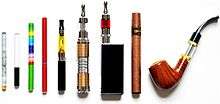
First-generation e-cigarettes tend to look like tobacco cigarettes and so are called "cigalikes".[19] The three parts of a cigalike e-cigarette initially were a cartridge, an atomizer, and a battery.[16] A cigalike e-cigarette currently contains a cartomizer (cartridge atomizer), which is connected to a battery.[16] Most cigalikes look like cigarettes but there is some variation in size.[16]
They may be a single unit comprising a battery, coil and filling saturated with e-liquid in a single tube to be used and discarded after the battery or e-liquid is depleted.[19] They may also be a reusable device with a battery and cartridge called a cartomizer.[22] The cartomizer cartridge can be separated from the battery so the battery can be charged and the empty cartomizer replaced when the e-liquid runs out.[19]
The battery section may contain an electronic airflow sensor triggered by drawing breath through the device.[22] Other models use a power button that must be held during operation.[22] An LED in the power button or on the end of the device may also show when the device is vaporizing.[68]
Charging is commonly accomplished with a USB charger that attaches to the battery.[69] Some manufacturers also have a cigarette pack-shaped portable charging case (PCC), which contains a larger battery capable of recharging the individual e-cigarette batteries.[70] Reusable devices can come in a kit that contains a battery, a charger, and at least one cartridge.[70] Varying nicotine concentrations are available and nicotine delivery to the user also varies based on different cartomizers, e-liquid mixtures, and power supplied by the battery.[11]
These manufacturing differences affect the way e-cigarettes convert the liquid solution to an aerosol, and thus the levels of ingredients, that are delivered to the user and the surrounding air for any given liquid.[11] First-generation e-cigarettes use lower voltages, around 3.7 V.[24]
Second-generation
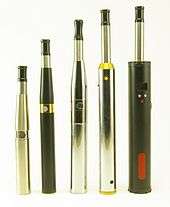
Second generation devices tend to be used by people with more experience.[22] They are larger overall and look less like tobacco cigarettes.[22] They usually consist of two sections, basically a tank and a separate battery. Their batteries have higher capacity, and are not removable.[19] Being rechargeable, they use a USB charger that attaches to the battery with a threaded connector. Certain batteries have a "passthrough" feature so they can be used even while they are charging.[5][71]
Second-generation e-cigarettes commonly use a tank or a "clearomizer".[22] Clearomizer tanks are meant to be refilled with e-liquid, while cartomizers are not.[19] Because they're refillable and the battery is rechargeable, their cost of operation is lower.[19] Hovever, they can also use cartomizers, which are pre-filled only.[19]
Some cheaper battery sections use a microphone that detects the turbulence of the air passing through to activate the device when the user inhales. Other batteries like the eGo style can use an integrated circuit, as well as a button for manual activation. The LED shows battery status. The power button can also switch off the battery so it is not activated accidentally.[72] Second generation e-cigarettes may have lower voltages, around 3.7 V.[24] However, adjustable-voltage devices can be set between 3 V and 6 V.[25]
Third-generation

The third-generation includes mechanical mods and variable voltage devices.[73][74] Battery sections are commonly called "mods," referencing their past when user modification was common.[19] Mechanical mods do not contain integrated circuits.[74] They are commonly cylindrical or box-shaped, and typical housing materials are wood, aluminium, stainless steel, or brass.[75] A larger "box mod" can hold bigger and sometimes multiple batteries.[75]
Mechanical mods and variable devices use larger batteries than those found in previous generations.[76] Common battery sizes used are 18350, 18490, 18500 and 18650.[77] The battery is often removable,[74] so it can be changed when depleted. The battery must be removed and charged externally.[74]
Variable devices permit setting wattage, voltage, or both.[5][74] These often have a USB connector for recharging; some can be used while charging, called a "passthrough" feature.[5][78]
The power section may include additional options such as screen readout, support for a wide range of internal batteries, and compatibility with different types of atomizers.[22] Third-generation devices can have rebuildable atomizers with different wicking materials.[19][22] These rebuildables use handmade coils that can be installed in the atomizer to increase vapor production.[76] Hardware in this generation is sometimes modified to increase power or flavor.[79]
The larger battery sections used also allow larger tanks to be attached that can hold more e-liquid.[75] Recent devices can go up to 8 V, which can heat the e-liquid significantly more than earlier generations.[24]
Fourth-generation
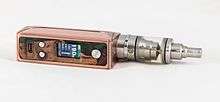
A fourth-generation e-cigarette became available in the United States in 2014.[46] Fourth-generation e-cigarettes can be made from stainless steel and pyrex glass, and contain very little plastics.[23] Included in the fourth-generation are sub ohm tanks and temperature control devices.[23] The e-cigarette user can breathe in large puff volumes, which results in a significant usage of e‐liquid per puff.[80] Usually used by experienced e-cigarettes users.[81]
Atomizer and tank
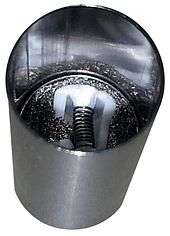
An atomizer consists of a small heating element that vaporizes e-liquid and a wicking material that draws liquid onto the coil.[5] Along with a battery and e-liquid the atomizer is the main component of every personal vaporizer.[22] A small length of resistance wire is coiled around the wicking material and connected to the integrated circuit, or in the case of mechanical devices, the atomizer is connected directly to the battery through either a 510, 808, or ego threaded connector.[82] 510 being the most common.[82] When activated, the resistance wire coil heats up and vaporizes the liquid, which is then inhaled by the user.[83]
The electrical resistance of the coil, the voltage output of the device, the airflow of the atomizer and the efficiency of the wick all affect the vapor coming from the atomizer.[84] They also affect the vapor quantity or volume yielded.[84]
Atomizer coils made of kanthal usually have resistances that vary from 0.4Ω (ohms) to 2.8Ω.[84] Coils of lower ohms have increased vapor production but could risk fire and dangerous battery failures if the user is not knowledgeable enough about electrical principles and how they relate to battery safety.[85]
Wicking materials vary from one atomizer to another.[86] "Rebuildable" or "do it yourself" atomizers can use silica, cotton, rayon, porous ceramic, hemp, bamboo yarn, oxidized stainless steel mesh and even wire rope cables as wicking materials.[86]
Cartomizers

The cartomizer was invented in 2007, integrating the heating coil into the liquid chamber.[87] A "cartomizer" (a portmanteau of cartridge and atomizer.[17]) or "carto" consists of an atomizer surrounded by a liquid-soaked poly-foam that acts as an e-liquid holder.[5] They can have up to 3 coils and each coil will increase vapor production.[5] The cartomizer is usually discarded when the e-liquid starts to taste burnt, which usually happens when the e-cigarette is activated with a dry coil or when the cartomizer gets consistently flooded (gurgling) because of sedimentation of the wick.[5] Most cartomizers are refillable even if not advertised as such.[5]
Cartomizers can be used on their own or in conjunction with a tank that allows more e-liquid capacity.[5] The portmanteau word "cartotank" has been coined for this.[88] When used in a tank, the cartomizer is inserted in a plastic, glass or metal tube and holes or slots have to be punched on the sides of the cartomizer so liquid can reach the coil.[5]
Clearomizers
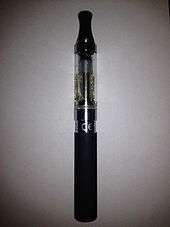

The clearomizer was invented in 2009 that originated from the cartomizer design.[87] It contained the wicking material, an e-liquid chamber, and an atomizer coil within a single clear component.[87] This allows the user to monitor the liquid level in the device.[87] Clearomizers or "clearos", are like cartotanks, in that an atomizer is inserted into the tank.[18] There are different wicking systems used inside clearomizers.[5] Some rely on gravity to bring the e-liquid to the wick and coil assembly (bottom coil clearomizers for example) and others rely on capillary action or to some degree the user agitating the e-liquid while handling the clearomizer (top coil clearomizers).[5] The coil and wicks are typically inside a prefabricated assembly or "head" that is replaceable by the user.[89]
Clearomizers are made with adjustable air flow control.[90] Tanks can be plastic or borosilicate glass.[91] Some flavors of e-liquid have been known to damage plastic clearomizer tanks.[91]
Rebuildable atomizers
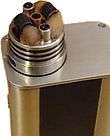
A rebuildable atomizer or an RBA is an atomizer that allows the user to assemble or "build" the wick and coil themselves instead of replacing them with off-the-shelf atomizer "heads".[19] They are generally considered advanced devices.[92] They also allow the user to build atomizers at any desired electrical resistance.[19]
These atomizers are divided into two main categories; rebuildable tank atomizers (RTAs) and rebuildable dripping atomizers (RDAs).[93]
Rebuildable tank atomizers (RTAs) have a tank to hold liquid that is absorbed by the wick.[94] They can hold up to 4 ml of e-liquid.[95] The tank can be either plastic, glass, or metal.[91] One form of tank atomizers was the Genesis style atomizers.[94] They can use ceramic wicks, stainless steel mesh or rope for wicking material.[94] The steel wick must be oxidized to prevent arcing of the coil.[94] Another type is the Sub ohm tank.[95] These tanks have rebuildable or RBA kits.[95] They can also use coil heads of 0.2 ohm, 0.4 ohm, and 0.5 ohm.[95] These coil heads can have stainless steel coils.[96]
Rebuildable dripping atomizers (RDAs) are atomizers where the e-liquid is dripped directly onto the coil and wick.[97] The common nicotine strength of e-liquids used in RDA's is 3 mg and 6 mg.[97] Liquids used in RDA's tend to have more vegetable glycerin.[97] A fully saturated wick can give you as many as 10-20 puffs.[98] They typically consist only of an atomizer "building deck", commonly with three posts with holes drilled in them, which can accept one or more coils.[79] The user needs to manually keep the atomizer wet by dripping liquid on the bare wick and coil assembly, hence their name.[97]
Kanthal wire is used in RDA's, RBA's, RTA's, in addition to clearomizers, tanks, and cartomizers.[5] Nickel wire or titanium wire can be used for temperature control.[97]
Squonk mods
The origins of a squonk mod bottom-feeding system go as far back as 2009.[99] A member of the E-Cigarette Forum (ECF) named "Carlos49" was largely credited with developing the first squonker available in the marketplace.[99] Squonk mods differ from other mod boxes with their construction.[99] Squonk mods have a 510 connection that have been modified with the use of an e-liquid bottle placed inside the mod.[5] The user squeezes an e-liquid bottle through an opening in the device to send e-liquid through a tube into the attached atomizer.[99] Extra liquid goes back into the bottle when it is unsqueezed.[99]
Pod mods
.jpg)
.jpg)
Pod mods heat up a liquid containing nicotine, flavors, and other ingredients that creates an aerosol.[28] Pod mods are lightweight, portable,[100] small, and reusable.[28] Pod mods do not require pushing a button.[101] A pod mod does not require much of a learning curve.[101] With the majority of pod mods, users can just open their new package, put a pod into the device, and begin vaping.[28] They are charged using a USB port.[101] There are numerous pod mods in the marketplace[102] and there are many kinds of pod mods.[103] The three categories for the different kinds of pod mods are an open system, a closed system, or those that use both.[103] Pod mods come in varying colors and flavors.[104] Many devices rely on replaceable liquid pods that may contain propylene glycol, glycerin, benzoic acid, nicotine, and artificial flavors.[105] Some pod mods can be refillable, with flavors such as cotton candy, donut cream, and gummy bear.[102] Pod mods that contain tetrahydrocannabinol (THC), the primary psychoactive chemical of cannabis, are being sold.[102] Pod mods can look like USB flash drives, cell phones, credit card holders, and highlighters.[106] Because pod mods are small and generate less aerosol, it makes it easy to hide them.[107] There are pod mods that can be concealed in the palm of a person's hand.[107] Later-generation pod mods are small like a Sharpie pen.[101] Pod mods cost about half as much as larger e-cigarettes.[101]
The latest generation of e-cigarettes, "pod products", such as Juul, have the highest nicotine content (59 mg/mL), in protonated salt, rather than the free-base nicotine form found in earlier generations, which makes it easier for less experienced users to inhale.[26] Pod mods deliver higher levels of nicotine than regular e-cigarettes.[27] One nicotine pod, in terms of nicotine, is roughly equivalent to one pack of regular cigarettes.[108] The labels on products state pods contain 59 mg/mL of nicotine, but the levels can be considerably greater such as 75 mg/mL of nicotine.[102] Some pod mods contained greater levels of nicotine than Juul which were as high as 6.5%.[109] In June 2015, Juul introduced a pod mod device.[110] British American Tobacco told to The Verge in 2018 that "They’ve been incorporated in our Vuse e-liquid in the US since 2012."[111]
Research on nicotine salts is limited.[100] Tests show that the pod mods Juul, Bo, Phix, and Sourin contain nicotine salts in a solution with propylene glycol and glycerin.[100] A nicotine base and a weak acid such as benzoic acid or levulinic acid is used to form a nicotine salt.[112] Benzoic acid is the most used acid to create a nicotine salt.[109] A free-base nicotine solution with an acid reduces the pH, which makes it possible to provide higher levels of nicotine without irritating the throat.[113] Nicotine salts are thought to amplify the level and rate of nicotine delivery to the user.[100] The speed of nicotine salts uptake into the body is close to the speed of nicotine uptake from traditional cigarettes.[114] Nicotine salts are less harsh and less bitter, and as a consequence e-liquids that contain nicotine salts are more tolerable even with high nicotine concentrations.[109] Traditional cigarettes provide high levels of nicotine, but with the bad taste of smoking.[28] Pod mods, however, can provide high levels of nicotine without the negative smoking experience.[28]
Power
Variable power and voltage devices
Variable devices are variable wattage, variable voltage or both.[5][74] Variable power and/or variable voltage have an electronic chip allowing the user to adjust the power applied to the heating element.[22][74] The amount of power applied to the coil affects the heat produced, thus changing the vapor output.[22][62] Greater heat from the coil increases vapor production.[62] Variable power devices monitor the coil's resistance and automatically adjust the voltage to apply the user-specified level of power to the coil.[115] Recent devices can go up to 8 V.[24]
They are often rectangular but can also be cylindrical.[75] They usually have a screen to show information such as voltage, power, and resistance of the coil.[116] To adjust the settings, the user presses buttons or rotates a dial to turn the power up or down.[62] Some of these devices include additional settings through their menu system such as: atomizer resistance meter, remaining battery voltage, puff counter, and power-off or lock.[117] The power source is the biggest component of an e-cigarette,[20] which is frequently a rechargeable lithium-ion battery.[12] Smaller devices contain smaller batteries and are easier to carry but typically require more repeated recharging.[12] Some e-cigarettes use a long lasting rechargeable battery, a non-rechargeable battery or a replaceable battery that is either rechargeable or non-rechargeable for power.[43] Some companies offer portable chargeable cases to recharge e-cigarettes.[43] Nickel-cadmium (NiCad), nickel metal-hydride (NiMh), lithium ion (Li-ion), alkaline and lithium polymer (Li-poly), and lithium manganese (LiMn) batteries have been used for the e-cigarettes power source.[43]

Temperature control devices
Temperature control devices allow the user to set the temperature.[97] There is a predictable change to the resistance of a coil when it is heated.[118] The resistance changes are different for different types of wires, and must have a high temperature coefficient of resistance.[118] Temperature control is done by detecting that resistance change to estimate the temperature and adjusting the voltage to the coil to match that estimate.[119]
Nickel, titanium, NiFe alloys, and certain grades of stainless steel are common materials used for wire in temperature control.[97] The most common wire used, kanthal, cannot be used because it has a stable resistance regardless of the coil temperature.[118] Nickel was the first wire used because it has the highest coefficient of the common metals.[118]
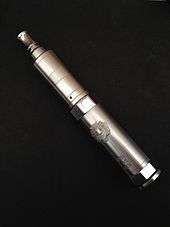
The temperature can be adjusted in Celsius or Fahrenheit.[120] The Evolv's DNA40 and YiHi's SX350J are control boards used in temperature control devices.[121] Temperature control can stop dry wicks from burning, or e-liquid overheating.[121]
Mechanical devices
Mechanical PVs or mechanical "mods", often called "mechs", are devices without integrated circuits, electronic battery protection, or voltage regulation.[74] They are activated by a switch.[97] They rely on the natural voltage output of the battery and the metal that the mod is made of often is used as part of the circuit itself.[122]
The term "mod" was originally used instead of "modification".[19] Users would modify existing hardwares to get better performance, and as an alternative to the e-cigarettes that looked like traditional cigarettes.[62] Users would also modify other unrelated items like flashlights as battery compartments to power atomizers.[62][75] The word mod is often used to describe most personal vaporizers.[5]
Mechanical PVs have no power regulation and are unprotected.[97] Because of this ensuring that the battery does not over-discharge and that the resistance of the atomizer requires electric current within the safety limits of the battery is the responsibility of the user.[122]
E-cigarette liquid
Composition
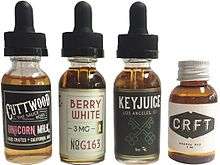
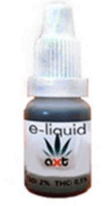
E-cigarette liquid,[124] E-Cig liquid,[8] e-liquid, juice, vapor juice, smoke juice,[12] vaping fluid,[125] vaping juice,[126] e-juice,[127] e-fluid,[14] or vape oil[128] is the mixture used in vapor products including e-cigarettes.[29] Since e-cigarettes are not regulated in many countries, the composition of the liquid can change often.[66] There is a great amount of variability in e-liquid formulations due to fast growth and changes in the manufacturing designs of e-cigarettes.[notes 1][16] The composition of the e-liquid for additives such as nicotine and flavors vary across and within brands.[31] E-liquids come in many variations, including different nicotine strengths and many different flavors.[130] The main ingredients are propylene glycol, glycerin, and flavorings; and most often, nicotine in liquid form.[131] The liquid typically consists of a combined total of 95% propylene glycol and glycerin, and the remaining 5% being flavorings, nicotine, and other additives.[32] The most frequently used e-liquid solvents are propylene glycol and glycerin.[132] Flavorings may contain menthol, sugars, esters, and pyrazines.[132] Flavor components include eucalyptol, camphor, methyl salicylate, pulegone, ethyl salicylate, cinnamaldehyde, eugenol, diphenyl ether, coumarin,[132] diacetyl, acetoin, 2,3-pentanedione, cyclohexanone, benzaldehyde, cresol, butyraldehyde, and isoamyl acetate.[81] Sugars are frequently used in e-liquids to provide a sweet flavor.[133] Diacetyl, acetoin, and 2,3-pentanedione are used for buttery flavoring.[81] Camphor and cyclohexanone are used for minty flavoring.[81] Benzaldehyde is used for cherry or almond flavoring.[81] Cinnamaldehyde is used for cinnamon flavoring.[81] Cresol is used for leathery or medicinal flavoring.[81] Butyraldehyde is used for chocolate flavoring.[81] Isoamyl acetate is used for banana flavoring.[81] E-liquids named coffee, tea, chocolate, or energy drinks, typically contain caffeine at levels considerably less than in comparison with dietary products.[134] E-liquids are also available with vitamins or cannabis flavors.[64] In addition, specific e-cigarettes (mods) are available that allow for not only liquids but also herbs, oils, or fruits to be vaped.[64] Moreover, dual-function devices handle both concentrates and e-liquids using multiple cartridges.[64]
E-liquid can be made with or without nicotine, with more than 90% of e-liquids containing some level of nicotine.[135] The most regularly used base carrier chemical is propylene glycol with or without glycerin.[11] E-liquid containing glycerin and water made without propylene glycol are also sold.[33] There are e-liquids sold without propylene glycol,[33] nicotine,[34] or flavors.[35] E-liquids containing THC or other cannabinoids is also sold.[123] Specific kinds of e-liquids contain a tiny amount of alcohol.[136] The amount of alcohol in e-liquids vary, and there are cases where it has not been disclosed as an ingredient.[137] It is uncertain whether the nicotine used in e-liquid is manufactured using a US Pharmacopeia grade nicotine, a tobacco plant or tobacco dust extract, or a synthetic nicotine.[138] Most e-cigarette liquids contain nicotine, but the level of nicotine varies depending on user-preference and manufacturers.[139] Although some e-liquid is nicotine-free, surveys demonstrate that 97% of respondents use products that contain nicotine.[140] About 3.5% of users use liquid without nicotine.[141] An e-cigarette user used approximately three flavors.[136] A 2016 study showed that measurable amounts of arsenic, nickel and other metals were in e-liquids.[142]
Over 80 chemicals such as formaldehyde and metallic nanoparticles have been found in the e-liquid.[37] E-liquids typically contain nicotine, propylene glycol, glycerin, 1,3-butanediol, 1,3-propanediol, ethylene glycol, menthol, safrole, ethyl vanillin, camphor, α-thujone, coumarin, and diethylene glycol, according to a 2017 review.[143] E-liquid can contain a range of toxicants and can contain impurities.[144] A 2013 study found the e-liquids tested had as high as five times the upper threshold permitted levels of impurities.[144] E-liquids have been found to contain low levels of some of the toxicants found in tobacco smoke, as well as small concentrations of carcinogens.[145] The FDA in 2009 analyzed e-liquid cartridge samples which were found to contain tobacco-specific nitrosamines (TSNAs), diethylene glycol (detected one e-cigarette cartridge), cotinine, anabasine, myosmine, and beta-nicotyrine.[146] The TSNAs N-nitrosonornicotine (NNN), 4-(methylnitrosamino)-1-(3-pyridyl)-1-butanone (NNK), N-nitrosoanabasine, and nitrosoanatabine have been detected in five e-liquid cartridge samples from two companies in levels comparable to nicotine replacement products, according to the results of the FDA's analysis.[146] TSNAs were found in a broad range of levels.[147] TSNAs present in tobacco smoke, were also found in e-liquids, at different levels, in trace amounts.[148] Studies in 2013 of other e-liquids had not detected diethylene glycol.[145] The majority of the e-liquids analyzed contained NNN from 0.34–60.08 μg/L and contained NNK from 0.22–9.84 μg/L.[149] The FDA issued warnings to several e-cigarette companies for selling e-cartridges and refill solutions containing active pharmaceutical ingredients such as rimonabant (Zimulti®) for the purpose of losing weight and reducing smoking addiction, and tadalafil (the active ingredient in Cialis®) for the purpose of increasing sexual capacity.[150] FDA analyses of these e-cartridges and solutions showed the presence of amino-tadalafil and not tadalafil, and the presence of an oxidative product of rimonabant, as well as rimonabant.[150]
The e-liquid often contain other substances unknown and/or undisclosed to the user.[151] The specific origin of the e-liquid ingredients is often unclear.[152] When content information is given on the packaging, it is usually incomplete.[31] Contamination with various compounds in e-liquids is a result of poor quality control.[31] Some nicotine and TSNAs have been found in e-liquids labelled as 'no nicotine'.[31] Nicotine content information on labels for some e-liquid companies may be vague, inaccurate or absent.[145] E-liquid were found to contain low levels of anthracene, phenanthrene, 1-methyl phenanthrene and pyren.[153] Diethylene glycol, ethylene glycol, hydrocarbons, ethanol, terpenic compounds and aldehydes, particularly formaldehyde and acrolein were found in the e-liquid.[154] Diethylene glycol is a potential byproduct of propylene glycol.[16] A 2014 study showed that e-liquids from a specific manufacturer contained greater amounts of ethylene glycol than glycerin or propylene glycol, which was likely a result of improper manufacturing methods.[155] Some liquids contained residual solvents such as 1,3-butadiene, cyclohexane, and acetone.[154] Some e-liquids contain tobacco alkaloids such as nornicotine, anabasine, or anatabine, and TSNAs, such as N-nitrosonornicotine (NNN), 4-(methylnitrosamine)-1-(3-pyridyl)-1-butanone (NNK),[16] nitrates, and phenol.[155] Tobacco alkaloids that were identified in some e-liquids were not found on the ingredient list.[155] Small quantities of volatile organic compounds (VOCs) such as benzene, toluene, xylene, and styrene have been found in the e-liquid.[41] Diethyl phthalate and diethylhexyl phthalate have been found in e-liquids.[156] Some e-liquids contain tin "whiskers," microscopic crystals that originate from tin in the solder joints.[16]
Levels of aldehydes in e-liquid
| Company | Code | Formaldehyde | Acetaldehyde | Propionaldehyde | Crotonaldehyde | Butyraldehyde | Benzaldehyde | Hexaldehyde |
|---|---|---|---|---|---|---|---|---|
| LOD | 0.060 | 0.030 | 0.043 | 0.053 | 0.077 | 0.035 | 0.036 | |
| Janty | H60339 | 0.497 | 0.728 | 0.043 | <0.053 | <0.077 | <0.035 | <0.036 |
| Ecigexpress | H60346 | 0.161 | 1.74 | <0.043 | <0.053 | 0.186 | 0.160 | <0.036 |
| Vapor4Life | H60349 | 0.776 | 0.507 | 0.089 | <0.053 | 0.217 | 40.0 | <0.036 |
| Totally Wicked | H60352 | 0.532 | 0.129 | <0.043 | <0.053 | <0.077 | 0.821 | <0.036 |
| Sedansa | H60355 | 0.813 | 1.25 | 0.167 | <0.053 | 0.164 | <0.035 | <0.036 |
| Johnson Creek | H60360 | 0.356 | 2.58 | 0.122 | <0.053 | <0.077 | 0.291 | <0.036 |
| TECC | H60364 | 0.467 | 0.235 | <0.043 | <0.053 | <0.077 | 0.078 | <0.036 |
| Intellicig | H60369 | 0.114 | 4.05 | 0.083 | <0.053 | <0.077 | 0.581 | <0.036 |
| e-cigarettes.fr | H60370 | 0.257 | 0.413 | <0.043 | <0.053 | <0.077 | 0.104 | 0.068 |
| CigLib | H60373 | 0.274 | 0.421 | <0.043 | <0.053 | <0.077 | 0.035 | 0.089 |
| V2 Cigs | H60374 | 0.411 | 0.332 | 0.045 | <0.053 | <0.077 | 0.146 | 0.115 |
| e-liquide.com | H60375 | 9.00 | 3.14 | <0.043 | <0.053 | <0.077 | 0.145 | 0.100 |
| Tasty Vapor | H60376 | 3.52 | 2.37 | <0.043 | <0.053 | <0.077 | 305 | 0.532 |
| e-cig.com | H60379 | 0.226 | 0.393 | 0.047 | <0.053 | <0.077 | 0.062 | 0.132 |
∗A 2013 analysis tested a total of 42 bottles of e-liquids.[157]
Contents
The e-liquid is sold in bottles or pre-filled disposable cartridges, or as a kit for consumers to make their own e-liquids.[158] Some vendors of e-liquids offer options to change the amounts of flavorings or nicotine strengths and build each bottle customized for the purchaser.[158] E-liquids are made with various tobacco, fruit, and other flavors,[11] as well as variable nicotine concentrations (including nicotine-free versions).[131] The standard notation "mg/ml" is often used on labels to denote nicotine concentration, and is sometimes shortened to "mg".[159] Some flavors are created to resemble the flavors used in traditional cigarettes such as tobacco and menthol-tobacco.[137] Adults in general also preferred sweet flavors (though smokers like tobacco flavor the most) and disliked flavors that elicit bitterness or harshness.[160] Young adults overall preferred sweet, menthol, and cherry flavors, while non-smokers in particular preferred coffee and menthol flavors.[160] In surveys of regular e-cigarette users, the most popular e-liquids had a nicotine content of 18 mg/ml, and the preferred flavors were largely tobacco, mint and fruit.[145] Men tend to favor flavors with tobacco, while women tend to favor chocolate or sweet flavors.[152] The most favorite flavors among regular e-cigarette users reported in a 2017 UK survey were fruit, tobacco, and menthol/mint.[161] The survey also found 2.6% regular e-cigarette users used no flavors.[161] A 2013 study examined 33 countries and found that only 1% of the adult smokers exclusively used non-nicotine e-cigarettes.[160] A cartridge may contain 0 to 20 mg of nicotine.[162] Refill liquids are often sold in the size range from 15 to 30 ml.[163] E-liquids are frequently sold in dropper bottles.[164] One cartridge may typically last as long as one pack of cigarettes.[165] A refill bottle can contain up to 100 mg/ml of nicotine,[162] which is meant to be diluted before use.[166] Some users, probably due to financial reasons and the willingness to experiment, are opting to make homemade e-liquids.[29] A small percentage of liquids without flavoring is also sold.[167] The flavorings may be natural or artificial.[31] Certified organic e-liquid is also sold.[36] About 8,000 flavors existed in 2014.[168] More than 15,500 flavors existed in 2018.[39] A user does not normally consume a whole cartridge in a single session.[169] Most e-liquids are produced by a few manufacturers in China, the US, and Europe.[145] An e-cigarette user will usually obtain 300 to 500 puffs per ml of e-liquid.[163] A 2017 survey found that 62.2% of everyday e-cigarette users stated using lower than 4 ml daily and 1.5% used higher than 10 ml daily.[170] 18.1% of everyday e-cigarette users were not aware of the amount of e-liquid they use.[170]
Manufacturing
E-liquids are manufactured by many producers, both in the US and across the world.[38] First tier manufacturers use lab suits, gloves, hair covers, inside of certified clean rooms with air filtration similar to pharmaceutical-grade production areas.[38]
Standards
E-liquid manufacturing requirements under the US Food and Drug Administration (FDA) rules include report user fee information, pay user fees, register their establishment and submit list of products, including labeling and advertisements, submit health documents, submit ingredient listing, include required warning statements on packages and advertisements, submit quantities of harmful and potentially harmful constituents, and submit a modified risk tobacco product application.[40] The revision to the EU Tobacco Products Directive has some standards for e-liquids.[41]
Standards for e-liquid manufacturing have been created by American E-liquid Manufacturing Standards Association (AEMSA), which is trade association dedicated to creating responsible and sustainable standards for the safe manufacturing of e-liquids used in vapor products.[171] AEMSA has published a comprehensive list standards and best known methods, which are openly available for use by any manufacturer of e-Liquids.[42] The AEMSA standards cover nicotine, ingredients, sanitary manufacturing rooms, safety packaging, age restrictions, and labeling.[42] AEMSA guidelines recommend that the nicotine levels in e-liquids be within the amount of ±10% from the levels stated on the label.[149]
Regulation
Effective August 8, 2016, under the FDA rules, a company that mixes or prepares e-liquids is regulated as a tobacco product manufacturer.[172] Under the same regulation, a company that sells e-liquids is regulated as a tobacco retailer.[172] Companies who import or try to sell for import into the US must conform to the Federal Food, Drug, and Cosmetic Act.[173] The 2016 FDA ruling did not incorporate regulation concerning flavoring of e-cigarettes.[174] Industry standards have been created and published by the American E-liquid Manufacturing Standards Association (AEMSA).[42] The FDA authority to regulate e-liquids was announced in May 2016.[175][176] The FDA has sought to regulate e-liquid in 2014[177] through use of the Family Smoking Prevention and Tobacco Control Act,[178] passed into law in June 2009.[179] In April 2014, the FDA issued its "Deeming" proposals for public comment, which would cover e-liquids manufacturing.[180]
Manufacturers of e-liquid in the UK are required to inform the Government regarding the content in each liquid.[181] The EU Tobacco Products Directive requires e-liquids to be tested 6 months before they are sold.[182]
The Tobacco Products Directive in the EU limits the sale of e-liquid.[183] It can only be sold in 10 ml bottles, which need to have a child-proof closure.[183] They have to be pre-registered to the Medicines and Healthcare products Regulatory Agency before sale.[183] There is also a limit on the nicotine content, meaning the nicotine strength of any e-liquid cannot exceed 20 mg/ml (2.0%).[183] Refill liquids in the EU with more than 20 mg/ml of nicotine may be sold with prior authorization from the pharmaceutical regulation.[41]
As of January 2020, the Food and Drug Administration put new regulations on the flavor of e-liquids. The ban companies from manufacturing any juices or pre-filled pods that contained fruity or minty flavors. This restriction also banned stores from selling any flavors of e-liquid that are fruity or minty that could have been imported from a different country. [184]
Nicotine yield
Smoking a traditional cigarette yields between 0.5 and 1.5 mg of nicotine,[185] but the nicotine content of the cigarette is only weakly correlated with the levels of nicotine in the smoker's bloodstream.[186] The amount of nicotine in the e-cigarette aerosol varies widely either from puff-to-puff or among devices of the same company.[9] In practice e-cigarette users tend to reach lower blood nicotine concentrations than smokers, particularly when the users are inexperienced[185] or using first-generation devices.[19] Nicotine in cigarette smoke is absorbed into the bloodstream rapidly, and e-cigarette aerosol is relatively slow in this regard.[19] Vaping typically gives a lower amount of nicotine per puff than smoking cigarettes.[187] E-liquids contain nicotine in a variety of different strengths[188] including high strength (18 mg/ml (1,8% of nicotine)[189]), medium strength, low strength (6 mg/ml (0,6% of nicotine), very low strength, and no nicotine.[190] An average a regular cigarette contains 6-28 mg of nicotine or the user will inhale about 1.1 to 1.8 mg of nicotine if just a portion is used.[191] On average an e-cigarette contain 0.5-15.4 mg of nicotine per 15 puffs.[191] The concentration of nicotine in e-liquid ranges up to 36 mg/ml.[192] In practice the nicotine concentration in an e-liquid is not a reliable guide to the amount of nicotine that reaches the bloodstream.[193]
Notes
- The liquid composition of each brand of e-cigarettes may differ, making it difficult to generalize about the potential toxic properties of these devices.[129]
Bibliography
- McNeill, A; Brose, LS; Calder, R; Bauld, L; Robson, D (February 2018). "Evidence review of e-cigarettes and heated tobacco products 2018" (PDF). UK: Public Health England. pp. 1–243.
- Stratton, Kathleen; Kwan, Leslie Y.; Eaton, David L. (January 2018). Public Health Consequences of E-Cigarettes (PDF). National Academies of Sciences, Engineering, and Medicine. National Academies Press. pp. 1–774. doi:10.17226/24952. ISBN 978-0-309-46834-3. PMID 29894118.
- McNeill, A; Brose, LS; Calder, R; Hitchman, SC; Hajek, P; McRobbie, H (August 2015). "E-cigarettes: an evidence update" (PDF). UK: Public Health England. pp. 1–113.
References
- Caponnetto, Pasquale; Campagna, Davide; Papale, Gabriella; Russo, Cristina; Polosa, Riccardo (2012). "The emerging phenomenon of electronic cigarettes". Expert Review of Respiratory Medicine. 6 (1): 63–74. doi:10.1586/ers.11.92. ISSN 1747-6348. PMID 22283580.
- Duff, Eamonn (15 September 2013). "Cigarette phase-out considered as trial tests if vapour safer". The Sydney Morning Herald.
- "Electronic Cigarette Fires and Explosions in the United States 2009 - 2016" (PDF). United States Fire Administration. July 2017. pp. 1–56.

- Steve K (19 February 2014). "What is an e-Cigarette MOD E-cig 101". Steve K's Vaping World.
- "Vaping Terminology – Updated 2016". Spinfuel eMagazine. 17 December 2014.
- Rahman MA, Hann N, Wilson A, Worrall-Carter L (2014). "Electronic cigarettes: patterns of use, health effects, use in smoking cessation and regulatory issues". Tob Induc Dis. 12 (1): 21. doi:10.1186/1617-9625-12-21. PMC 4350653. PMID 25745382.CS1 maint: uses authors parameter (link)
- Kaisar, Mohammad Abul; Prasad, Shikha; Liles, Tylor; Cucullo, Luca (2016). "A Decade of e-Cigarettes: Limited Research & Unresolved Safety Concerns". Toxicology. 365: 67–75. doi:10.1016/j.tox.2016.07.020. ISSN 0300-483X. PMC 4993660. PMID 27477296.
- Rowell, Temperance R; Tarran, Robert (2015). "Will Chronic E-Cigarette Use Cause Lung Disease?". American Journal of Physiology. Lung Cellular and Molecular Physiology. 309 (12): L1398–L1409. doi:10.1152/ajplung.00272.2015. ISSN 1040-0605. PMC 4683316. PMID 26408554.
- Cheng, T. (2014). "Chemical evaluation of electronic cigarettes". Tobacco Control. 23 (Supplement 2): ii11–ii17. doi:10.1136/tobaccocontrol-2013-051482. ISSN 0964-4563. PMC 3995255. PMID 24732157.
- Pepper, J. K.; Brewer, N. T. (2013). "Electronic nicotine delivery system (electronic cigarette) awareness, use, reactions and beliefs: a systematic review". Tobacco Control. 23 (5): 375–384. doi:10.1136/tobaccocontrol-2013-051122. ISSN 0964-4563. PMC 4520227. PMID 24259045.
- Grana, R; Benowitz, N; Glantz, SA (13 May 2014). "E-cigarettes: a scientific review". Circulation. 129 (19): 1972–86. doi:10.1161/circulationaha.114.007667. PMC 4018182. PMID 24821826.
- Orellana-Barrios, Menfil A.; Payne, Drew; Mulkey, Zachary; Nugent, Kenneth (2015). "Electronic cigarettes-a narrative review for clinicians". The American Journal of Medicine. 128 (7): 674–81. doi:10.1016/j.amjmed.2015.01.033. ISSN 0002-9343. PMID 25731134.
- Schraufnagel, Dean E.; Blasi, Francesco; Drummond, M. Bradley; Lam, David C. L.; Latif, Ehsan; Rosen, Mark J.; Sansores, Raul; Van Zyl-Smit, Richard (2014). "Electronic Cigarettes. A Position Statement of the Forum of International Respiratory Societies". American Journal of Respiratory and Critical Care Medicine. 190 (6): 611–618. doi:10.1164/rccm.201407-1198PP. ISSN 1073-449X. PMID 25006874.
- Ebbert, Jon O.; Agunwamba, Amenah A.; Rutten, Lila J. (2015). "Counseling Patients on the Use of Electronic Cigarettes". Mayo Clinic Proceedings. 90 (1): 128–134. doi:10.1016/j.mayocp.2014.11.004. ISSN 0025-6196. PMID 25572196.
- McNeill 2015, p. 15.
- Bhatnagar, A.; Whitsel, L. P.; Ribisl, K. M.; Bullen, C.; Chaloupka, F.; Piano, M. R.; Robertson, R. M.; McAuley, T.; Goff, D.; Benowitz, N. (2014). "Electronic Cigarettes: A Policy Statement From the American Heart Association" (PDF). Circulation. 130 (16): 1418–1436. doi:10.1161/CIR.0000000000000107. ISSN 0009-7322. PMID 25156991.
- "Logic Premium Electronic Cigarettes". PC Magazine. 30 July 2013.
- Greg Olson (29 January 2014). "Smoking going electronic". Civistas Media. Journal-Courier.
- Farsalinos, Konstantinos E.; Spyrou, Alketa; Tsimopoulou, Kalliroi; Stefopoulos, Christos; Romagna, Giorgio; Voudris, Vassilis (2014). "Nicotine absorption from electronic cigarette use: comparison between first and new-generation devices". Scientific Reports. 4: 4133. Bibcode:2014NatSR...4E4133F. doi:10.1038/srep04133. ISSN 2045-2322. PMC 3935206. PMID 24569565.
- Rom, Oren; Pecorelli, Alessandra; Valacchi, Giuseppe; Reznick, Abraham Z. (2014). "Are E-cigarettes a safe and good alternative to cigarette smoking?". Annals of the New York Academy of Sciences. 1340 (1): 65–74. Bibcode:2015NYASA1340...65R. doi:10.1111/nyas.12609. ISSN 0077-8923. PMID 25557889.
- Glasser, A. M.; Cobb, C. O.; Teplitskaya, L.; Ganz, O.; Katz, L.; Rose, S. W.; Feirman, S.; Villanti, A. C. (2015). "Electronic nicotine delivery devices, and their impact on health and patterns of tobacco use: a systematic review protocol". BMJ Open. 5 (4): e007688. doi:10.1136/bmjopen-2015-007688. ISSN 2044-6055. PMC 4420972. PMID 25926149.
- Hayden McRobbie (2014). "Electronic cigarettes" (PDF). National Centre for Smoking Cessation and Training. pp. 1–16.
- Konstantinos Farsalinos (2015). "Electronic cigarette evolution from the first to fourth-generation and beyond" (PDF). gfn.net.co. Global Forum on Nicotine. p. 23. Archived from the original (PDF) on 2015-07-08.
- Crotty Alexander LE, Vyas A, Schraufnagel DE, Malhotra A (2015). "Electronic cigarettes: the new face of nicotine delivery and addiction". J Thorac Dis. 7 (8): E248–51. doi:10.3978/j.issn.2072-1439.2015.07.37. PMC 4561260. PMID 26380791.
- Tom McBride (11 February 2013). "Vaping Basics – VAPE GEAR". Spinfuel eMagazine.
- Jenssen, Brian P.; Boykan, Rachel (2019). "Electronic Cigarettes and Youth in the United States: A Call to Action (at the Local, National and Global Levels)". Children. 6 (2): 30. doi:10.3390/children6020030. ISSN 2227-9067. PMC 6406299. PMID 30791645.

- Weedston, Lindsey (8 April 2019). "FDA To Investigate Whether Vaping Causes Seizures". The Fix.
- Barrington-Trimis, Jessica L.; Leventhal, Adam M. (2018). "Adolescents' Use of "Pod Mod" E-Cigarettes — Urgent Concerns". New England Journal of Medicine. 379 (12): 1099–1102. doi:10.1056/NEJMp1805758. ISSN 0028-4793. PMID 30134127.
- Jankowski, Mateusz; Brożek, Grzegorz; Lawson, Joshua; Skoczyński, Szymon; Zejda, Jan (2017). "E-smoking: Emerging public health problem?". International Journal of Occupational Medicine and Environmental Health. 30 (3): 329–344. doi:10.13075/ijomeh.1896.01046. ISSN 1232-1087. PMID 28481369.
- England, Lucinda J.; Bunnell, Rebecca E.; Pechacek, Terry F.; Tong, Van T.; McAfee, Tim A. (2015). "Nicotine and the Developing Human". American Journal of Preventive Medicine. 49 (2): 286–293. doi:10.1016/j.amepre.2015.01.015. ISSN 0749-3797. PMC 4594223. PMID 25794473.
- Bertholon, J.F.; Becquemin, M.H.; Annesi-Maesano, I.; Dautzenberg, B. (2013). "Electronic Cigarettes: A Short Review". Respiration. 86 (5): 433–8. doi:10.1159/000353253. ISSN 1423-0356. PMID 24080743.
- Jimenez Ruiz, CA; Solano Reina, S; de Granda Orive, JI; Signes-Costa Minaya, J; de Higes Martinez, E; Riesco Miranda, JA; Altet Gómez, N; Lorza Blasco, JJ; Barrueco Ferrero, M; de Lucas Ramos, P (August 2014). "The electronic cigarette. Official statement of the Spanish Society of Pneumology and Thoracic Surgery (SEPAR) on the efficacy, safety and regulation of electronic cigarettes". Archivos de Bronconeumologia. 50 (8): 362–7. doi:10.1016/j.arbres.2014.02.006. PMID 24684764.
- Oh, Anne Y.; Kacker, Ashutosh (December 2014). "Do electronic cigarettes impart a lower potential disease burden than conventional tobacco cigarettes?: Review on e-cigarette vapor versus tobacco smoke". The Laryngoscope. 124 (12): 2702–2706. doi:10.1002/lary.24750. PMID 25302452.
- Leduc, Charlotte; Quoix, Elisabeth (2016). "Is there a role for e-cigarettes in smoking cessation?". Therapeutic Advances in Respiratory Disease. 10 (2): 130–135. doi:10.1177/1753465815621233. ISSN 1753-4658. PMC 5933562. PMID 26668136.
- Wilder, Natalie; Daley, Claire; Sugarman, Jane; Partridge, James (April 2016). "Nicotine without smoke: Tobacco harm reduction". UK: Royal College of Physicians. p. 82.
- Dan Nosowitz (5 June 2015). "America's First Certified Organic E-Cigarette Vaping Liquid Is Here". Modern Farmer.
- Thirión-Romero, Ireri; Pérez-Padilla, Rogelio; Zabert, Gustavo; Barrientos-Gutiérrez, Inti (2019). "Respiratory Impact of Electronic Cigarettes and Low-Risk Tobacco". Revista de investigación Clínica. 71 (1): 17–27. doi:10.24875/RIC.18002616. ISSN 0034-8376. PMID 30810544. S2CID 73511138.
- John Reid Blackwell (7 June 2015). "Avail Vapor offers glimpse into the 'art and science' of e-liquids". Richmond Times-Dispatch.
- Henry, Travis S.; Kligerman, Seth J.; Raptis, Constantine A.; Mann, Howard; Sechrist, Jacob W.; Kanne, Jeffrey P. (2020). "Imaging Findings of Vaping-Associated Lung Injury". American Journal of Roentgenology. 214 (3): 498–505. doi:10.2214/AJR.19.22251. ISSN 0361-803X. PMID 31593518.
- "Manufacturing". United States Food and Drug Administration. 12 August 2016.
- Famele, M.; Ferranti, C.; Abenavoli, C.; Palleschi, L.; Mancinelli, R.; Draisci, R. (2014). "The Chemical Components of Electronic Cigarette Cartridges and Refill Fluids: Review of Analytical Methods". Nicotine & Tobacco Research. 17 (3): 271–279. doi:10.1093/ntr/ntu197. ISSN 1462-2203. PMC 5479507. PMID 25257980.
- E-Liquid Manufacturing Standards (PDF). US: American E-Liquid Manufacturing Standards Association (AEMSA). 4 September 2015. pp. 1–13.
- Brown, C. J.; Cheng, J. M. (2014). "Electronic cigarettes: product characterisation and design considerations". Tobacco Control. 23 (Supplement 2): ii4–ii10. doi:10.1136/tobaccocontrol-2013-051476. ISSN 0964-4563. PMC 3995271. PMID 24732162.
- "Supporting regulation of electronic cigarettes". www.apha.org. US: American Public Health Association. 18 November 2014.
- Evans, S. E.; Hoffman, A. C. (2014). "Electronic cigarettes: abuse liability, topography and subjective effects". Tobacco Control. 23 (Supplement 2): ii23–ii29. doi:10.1136/tobaccocontrol-2013-051489. ISSN 0964-4563. PMC 3995256. PMID 24732159.
- Brandon, T. H.; Goniewicz, M. L.; Hanna, N. H.; Hatsukami, D. K.; Herbst, R. S.; Hobin, J. A.; Ostroff, J. S.; Shields, P. G.; Toll, B. A.; Tyne, C. A.; Viswanath, K.; Warren, G. W. (2015). "Electronic Nicotine Delivery Systems: A Policy Statement from the American Association for Cancer Research and the American Society of Clinical Oncology". Clinical Cancer Research. 21 (3): 514–525. doi:10.1158/1078-0432.CCR-14-2544. ISSN 1078-0432. PMID 25573384.
- Vaping360 Team (3 August 2018). "PG vs VG: What They Are and How to Use Them". Vaping360.
- Drope, Jeffrey; Cahn, Zachary; Kennedy, Rosemary; Liber, Alex C.; Stoklosa, Michal; Henson, Rosemarie; Douglas, Clifford E.; Drope, Jacqui (2017). "Key issues surrounding the health impacts of electronic nicotine delivery systems (ENDS) and other sources of nicotine". CA: A Cancer Journal for Clinicians. 67 (6): 449–471. doi:10.3322/caac.21413. ISSN 0007-9235. PMID 28961314.
- Couch ET, Chaffee BW, Gansky SA, Walsh MM (2016). "The changing tobacco landscape: What dental professionals need to know". J Am Dent Assoc. 147 (7): 561–9. doi:10.1016/j.adaj.2016.01.008. PMC 4925234. PMID 26988178.
- Liber, Alex C; Drope, Jeffrey M; Stoklosa, Michal (2017). "Combustible cigarettes cost less to use than e-cigarettes: global evidence and tax policy implications". Tobacco Control. 26 (2): 158–163. doi:10.1136/tobaccocontrol-2015-052874. ISSN 0964-4563. PMID 27022059.
- Franck, C.; Budlovsky, T.; Windle, S. B.; Filion, K. B.; Eisenberg, M. J. (2014). "Electronic Cigarettes in North America: History, Use, and Implications for Smoking Cessation". Circulation. 129 (19): 1945–1952. doi:10.1161/CIRCULATIONAHA.113.006416. ISSN 0009-7322. PMID 24821825.
- E-cigarette policy should consider environmental affects
- E-cigarettes: the new hazardous waste
- "Cigarette butts are toxic plastic pollution. Should they be banned?". Environment. 9 August 2019.
- Garner, Charles; Stevens, Robert (February 2014). "A Brief Description of History, Operation and Regulation" (PDF). Coresta. Archived from the original (PDF) on 3 March 2016.
- Oscar Raymundo (27 January 2015). "How to Get Started with E-Cigarettes". HuffPost.
- McQueen, Amy; Tower, Stephanie; Sumner, Walton (2011). "Interviews with "vapers": implications for future research with electronic cigarettes". Nicotine & Tobacco Research. 13 (9): 860–7. doi:10.1093/ntr/ntr088. PMID 21571692.
- SA, Meo; SA, Al Asiri (2014). "Effects of electronic cigarette smoking on human health" (PDF). Eur Rev Med Pharmacol Sci. 18 (21): 3315–9. PMID 25487945.
- Mary Plass (29 January 2014). "The Cloud Chasers". Vape News Magazine.
- Dominique Mosbergen (5 August 2014). "This Man Is An Athlete In The Sport Of 'Cloud Chasing'". HuffPost.
- Jérôme Cartegini (27 May 2014). "A la découverte de la cigarette électronique". Clubic. Archived from the original on 30 May 2014.
- Couts, Andrew (13 May 2013). "Inside the world of vapers, the subculture that might save smokers' lives". Digital Trends.
- Alex Hern (21 November 2014). "Now e-cigarettes can give you malware". The Guardian.
- Staal, Yvonne CM; van de Nobelen, Suzanne; Havermans, Anne; Talhout, Reinskje (2018). "New Tobacco and Tobacco-Related Products: Early Detection of Product Development, Marketing Strategies, and Consumer Interest". JMIR Public Health and Surveillance. 4 (2): e55. doi:10.2196/publichealth.7359. ISSN 2369-2960. PMC 5996176. PMID 29807884.

- Glantz, Stanton A.; Bareham, David W. (January 2018). "E-Cigarettes: Use, Effects on Smoking, Risks, and Policy Implications". Annual Review of Public Health. 39 (1): 215–235. doi:10.1146/annurev-publhealth-040617-013757. ISSN 0163-7525. PMC 6251310. PMID 29323609.

- Ramôa, C. P.; Eissenberg, T.; Sahingur, S. E. (2017). "Increasing popularity of waterpipe tobacco smoking and electronic cigarette use: Implications for oral healthcare". Journal of Periodontal Research. 52 (5): 813–823. doi:10.1111/jre.12458. ISSN 0022-3484. PMC 5585021. PMID 28393367.
- McCausland, Kahlia; Maycock, Bruce; Jancey, Jonine (2017). "The messages presented in online electronic cigarette promotions and discussions: a scoping review protocol". BMJ Open. 7 (11): e018633. doi:10.1136/bmjopen-2017-018633. ISSN 2044-6055. PMC 5695349. PMID 29122804.
- "The skyrocketing popularity of e-cigarettes: A guide". The Week. 20 August 2012.
- Tim Stevens (31 March 2009). "Thanko's USB-powered Health E-Cigarettes sound healthy". Engagdet.
- Terrence O'Brien (15 July 2011). "E-Lites electronic cigarette review". Engagdet.
- Farsalinos, K. E.; Polosa, R. (2014). "Safety evaluation and risk assessment of electronic cigarettes as tobacco cigarette substitutes: a systematic review". Therapeutic Advances in Drug Safety. 5 (2): 67–86. doi:10.1177/2042098614524430. ISSN 2042-0986. PMC 4110871. PMID 25083263.
- "Joyetech eCom". PCMag. Ziff Davis. 31 January 2014.
- Daniel Culpan (21 May 2015). "E-cigarettes may only be harmful under 'extreme conditions'". Condé Nast.
- Mark Benson (9 January 2015). "Are Third Generation Vaping Devices A Step Too Far?". Spinfuel eMagazine.
- Michael Grothaus (1 October 2014). "Trading addictions: the inside story of the e-cig modding scene". Engadget.
- Sean Cooper (23 May 2014). "What you need to know about vaporizers". Engadget.
- "Understanding MilliAmp Hours". Spinfuel eMagazine. 2 January 2014.
- "The Vapologist will see you now: Inside New York's first e-cigarette bar". The Week. 11 October 2013.
- Eric Larson (25 January 2014). "Pimp My Vape: The Rise of E-Cigarette Hackers". Mashable.
- Qasim, Hanan; Karim, Zubair A.; Rivera, Jose O.; Khasawneh, Fadi T.; Alshbool, Fatima Z. (2017). "Impact of Electronic Cigarettes on the Cardiovascular System". Journal of the American Heart Association. 6 (9): e006353. doi:10.1161/JAHA.117.006353. ISSN 2047-9980. PMC 5634286. PMID 28855171.
- Clapp, Phillip W.; Jaspers, Ilona (2017). "Electronic Cigarettes: Their Constituents and Potential Links to Asthma". Current Allergy and Asthma Reports. 17 (11): 79. doi:10.1007/s11882-017-0747-5. ISSN 1529-7322. PMC 5995565. PMID 28983782.
- John Castle (27 January 2014). "E Cigarettes And Clearomizers". Spinfuel eMagazine.
- EP application 2614731, Yonghai Li, Zhongli Xu, "An atomizer for electronic cigarette", published 17 July 2013
- Joseph C. Martin, III (2 September 2015). "The World of the [RDA] Coil". Spinfuel eMagazine.
- "Harding Battery Handbook For" (PDF). Harding Energy, Inc. Archived from the original (PDF) on 2015-12-27.
- Ngonngo, Nancy (28 September 2013). "As e-cigarette stores pop up in Twin Cities, so do the questions". Pioneer Press.
- Mike K (9 June 2015). "What Does The Future Hold For Vaping Technology?". Steve K's Vaping World.
- "lgaurejen". 17 February 2015.
- Arvid Sollom (9 May 2015). "Sub ohm tanks and the end of non hobbyist building". Vape Magazine.
- VAPE Magazine March EU Special. Vape Magazine. March 2015. p. 50.
- Lindsay Fox (24 March 2014). "E-Liquid and Tank Safety". EcigaretteReviewed.
- "The Rebuildable Atomizer – An Introduction And Overview". Spinfuel eMagazine. 7 January 2013.
- Matt Schramel (15 December 2013). "3 steps to rebuilding atomizers". Vapenews Magazine.
- Erick Potter (16 January 2014). "How to prepare a stainless steel wick and wrap a coil for a Genesis style rebuildable atomizer". Vape Magazine.
- Julia Hartley-Barnes (17 September 2015). "Vaping with Julia "Sub Ohm Tanks"". Spinfuel eMagazine.
- John Manzione (27 July 2015). "Aspire Triton Full Review".
- Jason Little (13 July 2015). "Guide To Dripping e Liquid". Spinfuel eMagazine.
- https://vapingcheap.com/rba-rda-guide-rebuildable-atomizers/
- Vaping360 Team (2 November 2017). "Best Squonk Mods 2017 - Ultimate Guide to Squonking". Vaping360.
- Goniewicz, Maciej Lukasz; Boykan, Rachel; Messina, Catherine R; Eliscu, Alison; Tolentino, Jonatan (2018). "High exposure to nicotine among adolescents who use Juul and other vape pod systems ('pods')". Tobacco Control. 28 (6): tobaccocontrol–2018–054565. doi:10.1136/tobaccocontrol-2018-054565. ISSN 0964-4563. PMC 6453732. PMID 30194085.
- Rachel Becker (6 May 2019). "Vaping technology 101: The latest trends in a growing industry". Toronto Sun.
- Spindle, Tory R.; Eissenberg, Thomas (2018). "Pod Mod Electronic Cigarettes—An Emerging Threat to Public Health". JAMA Network Open. 1 (6): e183518. doi:10.1001/jamanetworkopen.2018.3518. ISSN 2574-3805. PMC 7058175. PMID 30646245.
- Galstyan, Ellen; Galimov, Artur; Sussman, Steve (2018). "Commentary: The Emergence of Pod Mods at Vape Shops". Evaluation & the Health Professions. 42 (1): 118–124. doi:10.1177/0163278718812976. ISSN 0163-2787. PMC 6637958. PMID 30477337.
- Julia Belluz (1 May 2018). "Juul, the vape device teens are getting hooked on, explained". Vox.
- Bonilla, Alex; Blair, Alexander J.; Alamro, Suliman M.; Ward, Rebecca A.; Feldman, Michael B.; Dutko, Richard A.; Karagounis, Theodora K.; Johnson, Adam L.; Folch, Erik E.; Vyas, Jatin M. (2019). "Recurrent spontaneous pneumothoraces and vaping in an 18-year-old man: a case report and review of the literature". Journal of Medical Case Reports. 13 (1): 283. doi:10.1186/s13256-019-2215-4. ISSN 1752-1947. PMC 6732835. PMID 31495337.

- "Vaping Related Lung Illness: A Summary of the Public Health Risks and Recommendations for the Public". California Tobacco Control Program. California Department of Public Health. 26 September 2019. pp. 1–5.

- Cunningham, Aimee (23 October 2018). "Teens use Juul e-cigarettes much more often than other vaping products". Science News.
- "Statement from the Council of Chief Medical Officers of Health on the increasing rates of youth vaping in Canada". Public Health Agency of Canada. 11 April 2019.
- Jackler, Robert K; Ramamurthi, Divya (2019). "Nicotine arms race: JUUL and the high-nicotine product market". Tobacco Control. 28 (6): tobaccocontrol–2018–054796. doi:10.1136/tobaccocontrol-2018-054796. ISSN 0964-4563. PMID 30733312. S2CID 73433596.
- McKelvey, Karma; Baiocchi, Mike; Halpern-Felsher, Bonnie (2018). "Adolescents' and Young Adults' Use and Perceptions of Pod-Based Electronic Cigarettes". JAMA Network Open. 1 (6): e183535. doi:10.1001/jamanetworkopen.2018.3535. ISSN 2574-3805. PMC 6324423. PMID 30646249.
- Rachel Becker (21 November 2018). "Juul's nicotine salts are dominating the market — and other companies want in". The Verge.
- Voos, Natalie; Goniewicz, Maciej L.; Eissenberg, Thomas (2019). "What is the nicotine delivery profile of electronic cigarettes?". Expert Opinion on Drug Delivery. 16 (11): 1193–1203. doi:10.1080/17425247.2019.1665647. ISSN 1742-5247. PMC 6814574. PMID 31495244.
- Jenssen, Brian P.; Wilson, Karen M. (2019). "What is new in electronic-cigarettes research?". Current Opinion in Pediatrics. 31 (2): 262–266. doi:10.1097/MOP.0000000000000741. ISSN 1040-8703. PMC 6644064. PMID 30762705.
- "JUUL®: An Electronic Cigarette You Should Know About". American Academy of Family Physicians. 2019.
- Tom McBride (28 February 2013). "Taking The Mystery Out Of Variable Wattage". Spinfuel eMagazine.
- Beach, Dania (29 January 2014). "Vapor Corp. Launches New Store-in-Store VaporX(R) Retail Concept at Tobacco Plus Convenience Expo in Las Vegas". The Wall Street Journal. Archived from the original on 22 February 2014.
- "JoyeTech eVic Review". Real Electric Cigarettes Reviews. Archived from the original on 2015-02-24.
- Staff (8 December 2015). "Temperature Coefficients and Coil Wires".
- Tom McBride (8 December 2015). "Temperature Control Vaping: The Decision Is Yours".
- Spinfuel Staff (3 August 2015). "HCigar VT40 Evolv DNA40 Mod". Spinfuel eMagazine.
- Tim Hanlon (15 February 2015). "Temperature-controlled e-cigs: The next giant leap in harm reduction of nicotine use?". Gizmag.
- Dale Amann (10 February 2014). "Battery Safety and Ohm's Law". onVaping.
- Giroud, Christian; de Cesare, Mariangela; Berthet, Aurélie; Varlet, Vincent; Concha-Lozano, Nicolas; Favrat, Bernard (2015). "E-Cigarettes: A Review of New Trends in Cannabis Use". International Journal of Environmental Research and Public Health. 12 (8): 9988–10008. doi:10.3390/ijerph120809988. ISSN 1660-4601. PMC 4555324. PMID 26308021.
- "Bahraini MP backs call to scrap tax on e-cigarette imports". Zawya. 8 December 2019.
- M. Rosenberg, Joyce (10 October 2019). "Vaping fallout: Small stores suffer as vapers turn away". Associated Press.
- Julie Stalmer (31 May 2018). "Vaping's Wild West". San Diego Reader.
- "Experts Clear the Air on E-Cigarettes". Columbia University Mailman School of Public Health. 26 January 2018.
- Jarrett Lyons (5 October 2017). "Vaping is better for you than smoking cigarettes, says new study". Salon (website).
- Nansseu, Jobert Richie N.; Bigna, Jean Joel R. (2016). "Electronic Cigarettes for Curbing the Tobacco-Induced Burden of Noncommunicable Diseases: Evidence Revisited with Emphasis on Challenges in Sub-Saharan Africa". Pulmonary Medicine. 2016: 1–9. doi:10.1155/2016/4894352. ISSN 2090-1836. PMC 5220510. PMID 28116156.

- Bekki, Kanae; Uchiyama, Shigehisa; Ohta, Kazushi; Inaba, Yohei; Nakagome, Hideki; Kunugita, Naoki (2014). "Carbonyl Compounds Generated from Electronic Cigarettes". International Journal of Environmental Research and Public Health. 11 (11): 11192–11200. doi:10.3390/ijerph111111192. ISSN 1660-4601. PMC 4245608. PMID 25353061.
- Caponnetto, P.; Russo, C.; Bruno, C.M.; Alamo, A.; Amaradio, M.D.; Polosa, R. (March 2013). "Electronic cigarette: a possible substitute for cigarette dependence". Monaldi Archives for Chest Disease. 79 (1): 12–19. doi:10.4081/monaldi.2013.104. ISSN 1122-0643. PMID 23741941.
- Schick, Suzaynn F.; Blount, Benjamin C; Jacob, Peyton; Saliba, Najat A; Bernert, John T; El Hellani, Ahmad; Jatlow, Peter; Pappas, R Steve; Wang, Lanqing; Foulds, Jonathan; Ghosh, Arunava; Hecht, Stephen S; Gomez, John C; Martin, Jessica R; Mesaros, Clementina; Srivastava, Sanjay; St. Helen, Gideon; Tarran, Robert; Lorkiewicz, Pawel K; Blair, Ian A; Kimmel, Heather L; Doerschuk, Claire M.; Benowitz, Neal L; Bhatnagar, Aruni (2017). "Biomarkers of Exposure to New and Emerging Tobacco and Nicotine Delivery Products". American Journal of Physiology. Lung Cellular and Molecular Physiology. 313 (3): L425–L452. doi:10.1152/ajplung.00343.2016. ISSN 1040-0605. PMC 5626373. PMID 28522563.
- Stanton, Cassandra A; Villanti, Andrea C; Watson, Clifford; Delnevo, Cristine D (2016). "Flavoured tobacco products in the USA: synthesis of recent multidiscipline studies with implications for advancing tobacco regulatory science". Tobacco Control. 25 (Suppl 2): ii1–ii3. doi:10.1136/tobaccocontrol-2016-053486. ISSN 0964-4563. PMC 5518682. PMID 27856996.
- Stratton 2018, p. Other Toxicants, Caffeine; 197.
- Lynne Dawkins, John Turner, Amanda Roberts and Kirstie Soar (2013). "Vaping' profiles and preferences: an online survey of electronic cigarette users" (PDF). School of Psychology-University of East London.CS1 maint: uses authors parameter (link)
- Xiaolong Zheng; Daniel Dajun Zeng; Hsinchun Chen; Scott J. Leischow (22 January 2016). Smart Health: International Conference, ICSH 2015, Phoenix, AZ, USA, November 17-18, 2015. Revised Selected Papers. Springer. pp. 279–. ISBN 978-3-319-29175-8.
- DeVito, Elise E.; Krishnan-Sarin, Suchitra (2018). "E-cigarettes: Impact of E-Liquid Components and Device Characteristics on Nicotine Exposure". Current Neuropharmacology. 16 (4): 438–459. doi:10.2174/1570159X15666171016164430. ISSN 1570-159X. PMC 6018193. PMID 29046158.
- Chang, H. (2014). "Research gaps related to the environmental impacts of electronic cigarettes". Tobacco Control. 23 (Supplement 2): ii54–ii58. doi:10.1136/tobaccocontrol-2013-051480. ISSN 0964-4563. PMC 3995274. PMID 24732165.
- Burstyn, I (9 January 2014). "Peering through the mist: systematic review of what the chemistry of contaminants in electronic cigarettes tells us about health risks". BMC Public Health. 14: 18. doi:10.1186/1471-2458-14-18. PMC 3937158. PMID 24406205.
- Brandon, T. H.; Goniewicz, M. L.; Hanna, N. H.; Hatsukami, D. K.; Herbst, R. S.; Hobin, J. A.; Ostroff, J. S.; Shields, P. G.; Toll, B. A.; Tyne, C. A.; Viswanath, K.; Warren, G. W. (2015). "Electronic Nicotine Delivery Systems: A Policy Statement from the American Association for Cancer Research and the American Society of Clinical Oncology". Clinical Cancer Research. 21 (3): 514–525. doi:10.1158/1078-0432.CCR-14-2544. ISSN 1078-0432. PMID 25573384.
- Tomashefski, Amy (2016). "The perceived effects of electronic cigarettes on health by adult users: A state of the science systematic literature review". Journal of the American Association of Nurse Practitioners. 28 (9): 510–5. doi:10.1002/2327-6924.12358. ISSN 2327-6886. PMID 26997487.
- Chun, Lauren F; Moazed, Farzad; Calfee, Carolyn S; Matthay, Michael A.; Gotts, Jeffrey Earl (2017). "Pulmonary Toxicity of E-cigarettes". American Journal of Physiology. Lung Cellular and Molecular Physiology. 313 (2): L193–L206. doi:10.1152/ajplung.00071.2017. ISSN 1040-0605. PMC 5582932. PMID 28522559.
- Naskar, Subrata; Jakati, PraveenKumar (2017). ""Vaping:" Emergence of a new paraphernalia". Indian Journal of Psychological Medicine. 39 (5): 566–572. doi:10.4103/IJPSYM.IJPSYM_142_17. ISSN 0253-7176. PMC 5688881. PMID 29200550.
- Weaver, Michael; Breland, Alison; Spindle, Tory; Eissenberg, Thomas (2014). "Electronic Cigarettes". Journal of Addiction Medicine. 8 (4): 234–240. doi:10.1097/ADM.0000000000000043. ISSN 1932-0620. PMC 4123220. PMID 25089953.
- Hajek, P; Etter, JF; Benowitz, N; Eissenberg, T; McRobbie, H (31 July 2014). "Electronic cigarettes: review of use, content, safety, effects on smokers and potential for harm and benefit". Addiction. 109 (11): 1801–10. doi:10.1111/add.12659. PMC 4487785. PMID 25078252.
- Jerry JM, Collins GB, Streem D (2015). "E-cigarettes: Safe to recommend to patients?". Cleve Clin J Med. 82 (8): 521–6. doi:10.3949/ccjm.82a.14054. PMID 26270431.
- Naik, Pooja; Cucullo, Luca (2015). "Pathobiology of tobacco smoking and neurovascular disorders: untied strings and alternative products". Fluids and Barriers of the CNS. 12 (1): 25. doi:10.1186/s12987-015-0022-x. ISSN 2045-8118. PMC 4628383. PMID 26520792.
- Breland, Alison B.; Spindle, Tory; Weaver, Michael; Eissenberg, Thomas (2014). "Science and Electronic Cigarettes". Journal of Addiction Medicine. 8 (4): 223–233. doi:10.1097/ADM.0000000000000049. ISSN 1932-0620. PMC 4122311. PMID 25089952.
- Zulkifli, Aziemah; Abidin, Emilia Zainal; Abidin, Najihah Zainol; Amer Nordin, Amer Siddiq; Praveena, Sarva Mangala; Syed Ismail, Sharifah Norkhadijah; Rasdi, Irniza; Karuppiah, Karmegam; Rahman, Anita Abd (2016). "Electronic cigarettes: a systematic review of available studies on health risk assessment". Reviews on Environmental Health. 0 (1): 43–52. doi:10.1515/reveh-2015-0075. ISSN 2191-0308. PMID 27101543.
- Palazzolo, Dominic L. (November 2013). "Electronic cigarettes and vaping: a new challenge in clinical medicine and public health. A literature review". Frontiers in Public Health. 1 (56): 56. doi:10.3389/fpubh.2013.00056. PMC 3859972. PMID 24350225.

- Jenssen, Brian P.; Wilson, Karen M. (2017). "Tobacco Control and Treatment for the Pediatric Clinician: Practice, Policy, and Research Updates". Academic Pediatrics. 17 (3): 233–242. doi:10.1016/j.acap.2016.12.010. ISSN 1876-2859. PMID 28069410.
- "Electronic Cigarettes – An Overview" (PDF). German Cancer Research Center. 2013. pp. 3, 18.
- Orr, Michael S (2014). "Electronic cigarettes in the USA: a summary of available toxicology data and suggestions for the future: Table 1". Tobacco Control. 23 (suppl 2): ii18–ii22. doi:10.1136/tobaccocontrol-2013-051474. ISSN 0964-4563. PMC 3995288. PMID 24732158.
- Varlet, Vincent; Farsalinos, Konstantinos; Augsburger, Marc; Thomas, Aurélien; Etter, Jean-François (2015). "Toxicity Assessment of Refill Liquids for Electronic Cigarettes". International Journal of Environmental Research and Public Health. 12 (5): 4796–4815. doi:10.3390/ijerph120504796. ISSN 1660-4601. PMC 4454939. PMID 25941845.
- Dinakar, Chitra; Longo, Dan L.; O'Connor, George T. (2016). "The Health Effects of Electronic Cigarettes". New England Journal of Medicine. 375 (14): 1372–1381. doi:10.1056/NEJMra1502466. ISSN 0028-4793. PMID 27705269.
- Stratton 2018, p. Other Toxicants, Phthalates; 196.
- Varlet, Vincent; Farsalinos, Konstantinos; Augsburger, Marc; Thomas, Aurélien; Etter, Jean-François (2015). "Aldehydes (in µg/g) in 42 bottles of e-liquids, 2013". International Journal of Environmental Research and Public Health. 12 (5): 4796–4815. doi:10.3390/ijerph120504796. PMC 4454939. PMID 25941845.
- "E-liquid Mixing Guide – a Guide to DIY Mixing". Ecigarette Mag. 2014.
- Murray Laugesen (17 October 2007). "The Ruyan e-cigarette; Technical Information Sheet". Health New Zealand.
- Cormet-Boyaka, Estelle; Zare, Samane; Nemati, Mehdi; Zheng, Yuqing (2018). "A systematic review of consumer preference for e-cigarette attributes: Flavor, nicotine strength, and type". PLOS ONE. 13 (3): e0194145. Bibcode:2018PLoSO..1394145Z. doi:10.1371/journal.pone.0194145. ISSN 1932-6203. PMC 5854347. PMID 29543907.

- McNeill 2018, p. 95.
- Cervellin, Gianfranco; Borghi, Loris; Mattiuzzi, Camilla; Meschi, Tiziana; Favaloro, Emmanuel; Lippi, Giuseppe (2013). "E-Cigarettes and Cardiovascular Risk: Beyond Science and Mysticism". Seminars in Thrombosis and Hemostasis. 40 (1): 060–065. doi:10.1055/s-0033-1363468. ISSN 0094-6176. PMID 24343348.
- Hildick-Smith, Gordon J.; Pesko, Michael F.; Shearer, Lee; Hughes, Jenna M.; Chang, Jane; Loughlin, Gerald M.; Ipp, Lisa S. (2015). "A Practitioner's Guide to Electronic Cigarettes in the Adolescent Population". Journal of Adolescent Health. 57 (6): 574–9. doi:10.1016/j.jadohealth.2015.07.020. ISSN 1054-139X. PMID 26422289.
- Zainol Abidin, Najihah; Zainal Abidin, Emilia; Zulkifli, Aziemah; Karuppiah, Karmegam; Syed Ismail, Sharifah Norkhadijah; Amer Nordin, Amer Siddiq (2017). "Electronic cigarettes and indoor air quality: a review of studies using human volunteers". Reviews on Environmental Health. 0 (3): 235–244. doi:10.1515/reveh-2016-0059. ISSN 2191-0308. PMID 28107173.
- Odum, L. E.; O'Dell, K. A.; Schepers, J. S. (2012). "Electronic Cigarettes: Do They Have a Role in Smoking Cessation?". Journal of Pharmacy Practice. 25 (6): 611–614. doi:10.1177/0897190012451909. ISSN 0897-1900. PMID 22797832.
- Chatham-Stephens, Kevin; Law, Royal; Taylor, Ethel; Kieszak, Stephanie; Melstrom, Paul; Bunnell, Rebecca; Wang, Baoguang; Day, Hannah; Apelberg, Benjamin; Cantrell, Lee; Foster, Howell; Schier, Joshua G. (June 2016). "Exposure Calls to U. S. Poison Centers Involving Electronic Cigarettes and Conventional Cigarettes—September 2010–December 2014". Journal of Medical Toxicology. 12 (4): 350–357. doi:10.1007/s13181-016-0563-7. ISSN 1556-9039. PMC 5135675. PMID 27352081.
- Tierney, Peyton A; Karpinski, Clarissa D; Brown, Jessica E; Luo, Wentai; Pankow, James F (2016). "Flavour chemicals in electronic cigarette fluids". Tobacco Control. 25 (e1): e10–e15. doi:10.1136/tobaccocontrol-2014-052175. ISSN 0964-4563. PMC 4853541. PMID 25877377.
- "Backgrounder on WHO report on regulation of e-cigarettes and similar products". 26 August 2014.
- Pepper, J. K.; Brewer, N. T. (2013). "Electronic nicotine delivery system (electronic cigarette) awareness, use, reactions and beliefs: a systematic review". Tobacco Control. 23 (5): 375–384. doi:10.1136/tobaccocontrol-2013-051122. ISSN 0964-4563. PMC 4520227. PMID 24259045.
- McNeill 2018, p. 92.
- "About AEMSA". AEMSA. 2015.
- "Pipe, Cigar, and Vape Shops that Are Regulated as Both Retailers and Manufacturers". United States Food and Drug Administration. 8 August 2016.
- "Vaporizers, E-Cigarettes, and other Electronic Nicotine Delivery Systems (ENDS)". United States Food and Drug Administration. 7 August 2016.
- Biyani, Sneh; Derkay, Craig S. (2017). "E-cigarettes: An update on considerations for the otolaryngologist". International Journal of Pediatric Otorhinolaryngology. 94: 14–16. doi:10.1016/j.ijporl.2016.12.027. ISSN 0165-5876. PMID 28167004.
- Jen Christensen (5 May 2016). "FDA to extend tobacco regulations to e-cigarettes, other products". CNN.
- "FDA takes significant steps to protect Americans from dangers of tobacco through new regulation". United States Food and Drug Administration. 5 May 2016.
- "Products, Guidance & Regulations - Deeming – Extending Authorities to Additional Tobacco Products". United States Food and Drug Administration. 25 April 2014. Archived from the original on 26 April 2014.
- Brad Rodu (30 April 2014). "FDA regulation: Defining e-cigarettes as tobacco products". R Street Institute.
- "Compliance, Enforcement & Training - Tobacco Control Act". United States Food and Drug Administration. 17 January 2018.
- "FDA proposes to extend its tobacco authority to additional tobacco products, including e-cigarettes". United States Food and Drug Administration. 24 April 2014.
- Ashitha Nagesh (20 May 2016). "E-cigarette laws have changed – here's what you need to know". Metro (British newspaper).
- Matt Discombe (11 December 2016). "Why are there so many vaping shops in Gloucester and how is it sustainable?". Gloucestershire Live. Archived from the original on 12 December 2016.
- "E-cigarettes: regulations for consumer products". GOV.UK. 19 January 2018.
- "Vaporizers, E-Cigarettes, and other Electronic Nicotine Delivery Systems (ENDS)". FDA. 13 April 2020.
- Schroeder, M. J.; Hoffman, A. C. (2014). "Electronic cigarettes and nicotine clinical pharmacology". Tobacco Control. 23 (Supplement 2): ii30–ii35. doi:10.1136/tobaccocontrol-2013-051469. ISSN 0964-4563. PMC 3995273. PMID 24732160.
- Goniewicz, Maciej L.; Hajek, Peter; McRobbie, Hayden (2014). "Nicotine content of electronic cigarettes, its release in vapour and its consistency across batches: regulatory implications" (PDF). Addiction. 109 (3): 500–507. doi:10.1111/add.12410. ISSN 0965-2140. PMID 24345184.
- Bullen, Christopher (2014). "Electronic Cigarettes for Smoking Cessation". Current Cardiology Reports. 16 (11): 538. doi:10.1007/s11886-014-0538-8. ISSN 1523-3782. PMID 25303892.
- Nicotine Levels in Electronic Cigarettes
- Converting mg/ml to %
- E-cigarette puffing patterns associated with high and low nicotine e-liquid strength: effects on toxicant and carcinogen exposure (study protocol)
- How much nicotine is in a cigarette
- Kaisar, Mohammad Abul; Prasad, Shikha; Liles, Tylor; Cucullo, Luca (2016). "A Decade of e-Cigarettes: Limited Research & Unresolved Safety Concerns". Toxicology. 365: 67–75. doi:10.1016/j.tox.2016.07.020. ISSN 0300-483X. PMC 4993660. PMID 27477296.
- McNeill 2015, p. 69-70.
External links
